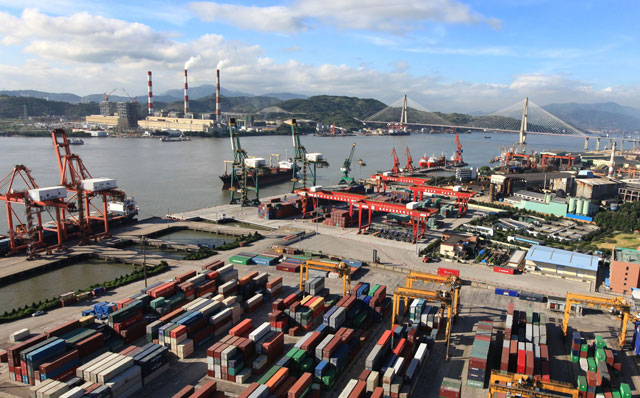
The Asian giant is the world's leading trader in goods but flagging expansion has led to a sharp fall in values for the resources it uses -such as iron ore and crude oil - hitting producer countries such as Australia.
September imports sank 20.4 percent to $145.2 billion in dollar terms, Customs said - worse than forecast in a survey of economists by Bloomberg News.
Purchases of several bulk commodities "exhibited an increase in volume and a fall in price", Customs department spokesman Huang Songping told reporters, citing oil, coal and copper costs among the biggest losers.
Crude purchase volumes were 8.8 percent higher over the first nine months of the year, he said.
Read: Pak-China trade: Importance of negotiating the FTA
Beijing is trying to transform the country’s economic model to a more sustainable one where consumers replace exports and state-led investment as the key driver of growth.
But the task is proving challenging. Expansion last year slowed to its lowest rate since 1990 and continues to soften despite policy supports including five interest rate cuts since November.
The central People's Bank of China has also slashed the cash lenders must keep in reserve four times this year to free up funds for lending to boost economic activity.
But growth still weakened to 7.0 percent in each of the first two quarters of the year after slowing to 7.3 percent in 2014.
The International Monetary Fund last week warned that the country could be headed for a hard landing unless leaders get a grip on the current challenges.
Feedback loop
Chinese demand for commodities has become a key driver of economic growth for many of its trade partners.
Huge investments by Beijing in infrastructure, such as country-wide high speed rail networks, once drove a seemingly endless demand for raw materials.
But slowing growth has resulted in a global slide in commodity prices - bad news for commodity-dependent supplier economies that have staked their future on constantly rising demand.
The downturn has created a feedback loop, analysts at China International Capital Corporation said.
“Weaker income growth of China's import partners has led to notably weaker demand for China’s own exports, a second order effect from China's weaker import demand."
Beijing two months ago devalued its normally stable yuan currency, lowering its central rate against the US dollar by nearly five percent within a week, which should have made its exports cheaper abroad.
Exports fell 3.7 percent in September to $205.6 billion, Customs said, but that was an improvement on August's decline and significantly better than the 6 percent drop forecast in a survey of economists by Bloomberg News.
"The yuan's depreciation in August definitely had a positive impact on exports," Huang said.
Read: On US visit, China's president seeks to reassure businesses on trade, security
In a note, Capital Economics economist Julian Evans-Pritchard said the "stronger-than-expected export figures hint at warming foreign demand".
Customs initially gave the statistics in yuan terms, which showed slightly smaller falls in both imports and exports.
The trade surplus for the month nearly doubled to $60.3 billion, it said.
Five year plan
China's Communist Party will meet later this month to plan the course of the economy over the next five years, and it has promised to address structural issues that have contributed to the instability.
Leaders claim they will increase the role of markets in driving the economy, although recent efforts to prop up falling stock prices have raised doubts about their ability and willingness to follow through.
One chronic problem has been overcapacity in heavy industry, including steel and concrete production -- although tackling that risks dashing suppliers' hopes for growing commodities use.
Recent poor economic numbers have raised expectations at home and abroad that Beijing will take stronger stimulus measures.
At the weekend Premier Li Keqiang urged local authorities to accelerate provisions of affordable housing, raising hopes that raw materials demand will rise.
Shanghai stocks were slightly lower by the break on Tuesday after the data's release, with the benchmark Shanghai Composite Index dropping 0.30 percent, while metals prices also fell.





1719053250-0/BeFunky-collage-(5)1719053250-0-270x192.webp)











COMMENTS
Comments are moderated and generally will be posted if they are on-topic and not abusive.
For more information, please see our Comments FAQ